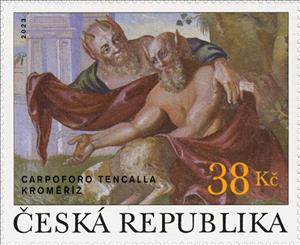Stamp: Mural by Carpoforo Tencalla (Czech Republic 2023)
Mural by Carpoforo Tencalla (Czech Republic 2023)
17 May (Czech Republic ) within release Baroque Mural Art (2023) goes into circulation Stamp Mural by Carpoforo Tencalla face value 38 Czech koruna
| Stamp Mural by Carpoforo Tencalla in catalogues | |
|---|---|
| POFIS: | POF: CZ 1204 |
Stamp is horizontal format.
stamp from souvenir sheetAlso in the issue Baroque Mural Art (2023):
- Souvenir Sheet - Baroque Mural Art face value 82;
- Stamp - Mural by Carpoforo Tencalla face value 38;
- Stamp - Mural by Godyn face value 44;
Stamp Mural by Carpoforo Tencalla it reflects the thematic directions:
Art is a diverse range of human activities in creating visual, auditory or performing artifacts (artworks), expressing the author's imaginative or technical skill, intended to be appreciated for their beauty or emotional power. In their most general form these activities include the production of works of art, the criticism of art, the study of the history of art, and the aesthetic dissemination of art. The oldest documented forms of art are visual arts, which include creation of images or objects in fields including painting, sculpture, printmaking, photography, and other visual media. Architecture is often included as one of the visual arts; however, like the decorative arts, or advertising, it involves the creation of objects where the practical considerations of use are essential—in a way that they usually are not in a painting, for example. Music, theatre, film, dance, and other performing arts, as well as literature and other media such as interactive media, are included in a broader definition of art or the arts. Until the 17th century, art referred to any skill or mastery and was not differentiated from crafts or sciences. In modern usage after the 17th century, where aesthetic considerations are paramount, the fine arts are separated and distinguished from acquired skills in general, such as the decorative or applied arts.
he Baroque or Baroquism is a Western style of architecture, music, dance, painting, sculpture, poetry, and other arts that flourished from the early 17th century until the 1750s. It followed Renaissance art and Mannerism and preceded the Rococo (in the past often referred to as "late Baroque") and Neoclassical styles. It was encouraged by the Catholic Church as a means to counter the simplicity and austerity of Protestant architecture, art, and music, though Lutheran Baroque art developed in parts of Europe as well


